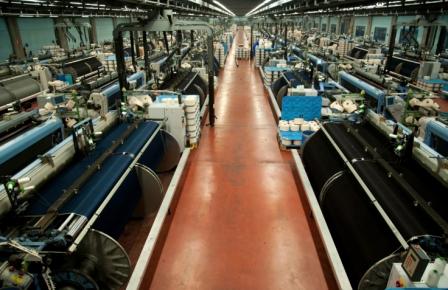Textile Mills Effluent Guidelines
 EPA promulgated the Textile Mills Effluent Guidelines (40 CFR Part 410) in 1974, and amended the regulation in 1977 and 1982. The regulation covers direct discharger
EPA promulgated the Textile Mills Effluent Guidelines (40 CFR Part 410) in 1974, and amended the regulation in 1977 and 1982. The regulation covers direct discharger![]() direct dischargerA point source that discharges pollutants to waters of the United States, such as streams, lakes, or oceans. facilities. The Textile Mills Effluent Guidelines are incorporated into NPDES permits.
direct dischargerA point source that discharges pollutants to waters of the United States, such as streams, lakes, or oceans. facilities. The Textile Mills Effluent Guidelines are incorporated into NPDES permits.
- What is the Textile Mills Industry?
- Facilities Covered
- Guidance and Studies
- Rulemaking History
- Additional Information
What is the Textile Mills Industry?
- receiving and preparing fibers
- transforming these materials into yarn, thread or webbing
- converting the yarn and webbing into fabric or related products; and
- finishing these materials.
Many facilities produce a final consumer product such as thread, yarn, bolt fabric, hosiery, towels, sheets and carpet, while the rest produce a transitional product for use by other establishments in the industry.
- wool scouring, topmaking, and general cleaning of raw wool
- wool finishing, including carbonizing, fulling, dyeing, bleaching, rinsing, fireproofing, and other similar processes
- yarn manufacture, unfinished fabric manufacture, fabric coating, fabric laminating, tire cord and fabric dipping, and carpet tufting and carpet backing
- woven fabric finishing, including desizing, bleaching, mercerizing, dyeing, printing, resin treatment, waterproofing, flameproofing, and application of soil repellency and other special finishes
- knit fabric finishing, including bleaching, mercerizing, dyeing, printing, resin treatment, waterproofing, flameproofing, and application of soil repellency and other special finishes
- carpet finishing, including bleaching, scouring, carbonizing, fulling, dyeing, printing, resin treatment, waterproofing, flameproofing, soil repellency, looping, and backing with foamed and unfoamed latex and jute
- stock and yarn finishing, including cleaning, scouring, bleaching, mercerizing, dyeing and special finishing
- manufacturing of nonwoven textile products of wool, cotton, or synthetics, or blends of such fabrics
Note: the NAICS listing is provided as a guide and does not define the coverage of the Textile Mills category. For precise definitions of coverage, see the applicability sections in 40 CFR Part 410.
Facilities Covered
- Wool Scouring
- Wool Finishing
- Low Water Use Processing
- Woven Fabric Finishing
- Knit Fabric Finishing
- Carpet Finishing
- Stock and Yarn Finishing
- Nonwoven Manufacturing
- Felted Fabric Processing
Guidance and Studies
- Industrial Stormwater Fact Sheet:
Sector V: Textile Mills, Apparel, and Other Fabric Product Manufacturing Facilities (December 2006) - Preliminary Study of the Textile Mills Category (July 1996)
Review of textile industry practices and processes, and analysis of new wastewater data collected by EPA in 1993-94, with a focus on potential revisions to Effluent Guidelines - Manual: Best Management Practices for Pollution Prevention in the Textile Industry (September 1996)
Overview of textile industry, descriptions of wastestreams and pollution prevention opportunities
Rulemaking History
1983 Correction
1982 Amendment
- Documents, including:
- Final rule: 47 FR 38810 (9/2/1982)
- Development Document (EPA 440/1-82/022, September 1982)
- Notice of Availability: 46 FR 8590 (1/27/1981)
- Proposed rule: 44 FR 62204 (10/29/1979)
- Final rule: 47 FR 38810 (9/2/1982)
1977 Amendment
- Documents, including:
- Final rule: 42 FR 26979 (5/26/1977)
- Proposed rule: 39 FR 24750 (7/5/1974)
1974 Initial Rulemaking
- Documents, including:
- Final rule: 39 FR 24736 (7/5/1974)
- Development Document (EPA 440/1-74/022a, June 1974)
- Proposed rule: 39 FR 4628 (2/5/1974)
- Final rule: 39 FR 24736 (7/5/1974)
Additional Information
For additional information regarding the Textile Mills Effluent Guidelines, please contact Ron Jordan (jordan.ronald@epa.gov) at 202-566-1003.
